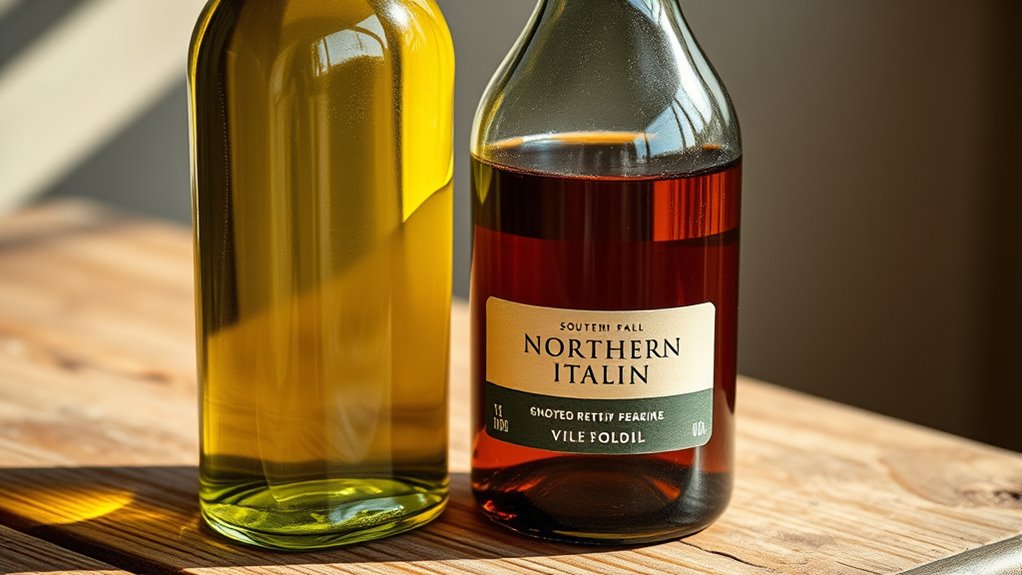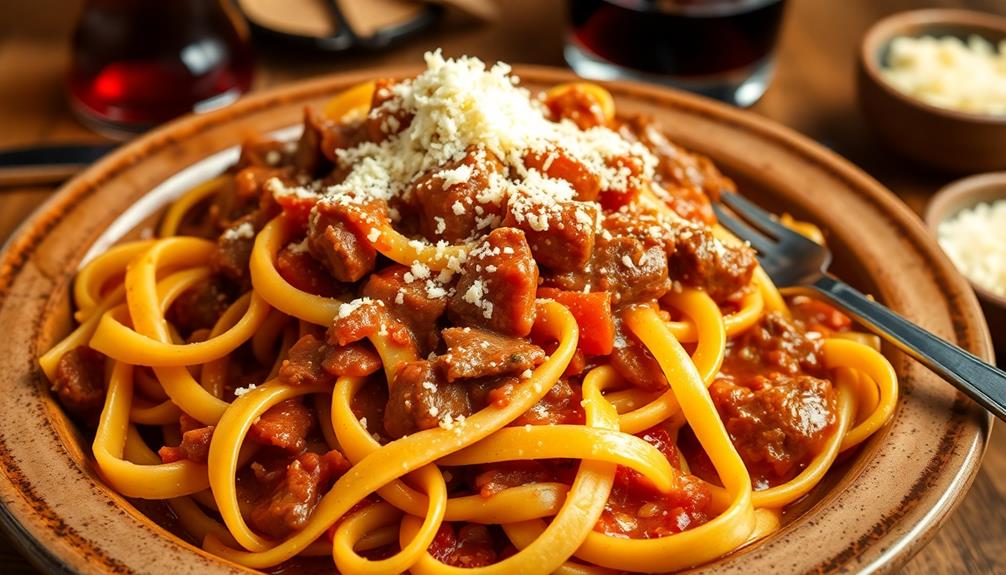Northern Italian olive oils tend to be lighter, delicate, and subtly grassy or herbal, thanks to cooler climates and well-drained soils. In contrast, southern oils are bolder, more robust, and full-bodied, with hints of ripe olives and spicy notes due to warmer Mediterranean temperatures. These regional differences influence flavor, aroma, and ideal culinary uses. Exploring further reveals how climate and terrain truly shape each oil’s unique character and quality.
Key Takeaways
- Northern Italian olive oils are lighter, delicate, with subtle grassy and herbal notes, ideal for refined dishes.
- Southern Italian oils are bold, robust, with pronounced fruitiness and spicy flavors, suitable for hearty recipes.
- Climate influences flavor: cooler northern regions produce refined oils, while warmer southern areas yield intense, full-bodied oils.
- Northern oils have a shorter growing season, leading to balanced flavors and a longer shelf life.
- Regional origin impacts flavor profiles, with Northern oils suited for delicate dishes and Southern oils for stronger, flavorful foods.

Italy’s diverse climate and terrain create distinct olive oil profiles across its regions, with northern and southern areas producing especially different flavors and characteristics. When you explore Italian olive oils, you’ll notice that the differences stem largely from how and where the olives are cultivated. Olive oil cultivation in Italy varies dramatically between the north and south, influenced by factors such as temperature, rainfall, soil type, and altitude. These elements shape not just how olives grow but also the flavor profile differences you’ll experience in each region’s oils.
Italy’s diverse climate and terrain create unique olive oil flavors across regions.
In northern Italy, the cooler climate and richer, well-drained soils tend to produce lighter, more delicate olive oils. These oils often have subtle grassy or herbal notes, with a hint of fruitiness that isn’t overpowering. Because the growing season here is shorter and the temperatures lower, the olives develop a more refined, less intense flavor. The flavor profile differences are noticeable—these oils typically feature a slightly peppery but balanced taste, making them perfect for drizzling over salads, seafood, or light dishes where you want the olive oil to complement rather than dominate. Additionally, the cooler temperatures can influence the oil stability and shelf life, ensuring fresher flavors over time. Climate factors also contribute to the olive oil quality, which varies based on regional conditions.
By contrast, southern Italy’s warmer Mediterranean climate fosters a different approach to olive oil cultivation. The hotter temperatures and abundant sunshine accelerate olives’ ripening process, resulting in oils with bolder, more robust flavors. These oils often exhibit pronounced fruitiness, with hints of ripe olives, herbs, and sometimes a spicy finish. The flavor profile differences are significant here—southern oils tend to be more intense, with a peppery kick that can stand up to hearty dishes like pasta with tomato sauce, grilled vegetables, or roasted meats. The soil composition, especially in regions like Sicily and Puglia, also contributes to the richness and complexity of the oils produced there.
Understanding these regional distinctions helps you choose the right olive oil for your cooking and tasting experience. Northern oils, with their lighter, nuanced flavors, are ideal for delicate dishes and finishing touches. Southern oils, with their boldness and depth, work well in recipes that benefit from a stronger olive oil presence. Additionally, the climate and terrain of each region play a crucial role in shaping the flavor profiles, highlighting the importance of geographical factors in olive oil quality and character. The key lies in recognizing how flavors evolve based on where and how the olives are cultivated. Whether you prefer the subtlety of northern oils or the intensity of southern varieties, appreciating these differences elevates your culinary experience and deepens your connection to Italy’s rich olive oil tradition.
Frequently Asked Questions
How Do Climate Differences Affect Olive Oil Flavor Profiles?
Climate differences profoundly influence olive oil flavor profiles through microclimate effects and harvest timing. Warmer, sunnier conditions boost fruit ripening, resulting in richer, fruitier oils with more robust flavors. Cooler climates delay harvest, preserving fresher, greener notes. You’ll notice these variations based on microclimate effects, which shape the olives’ development. Precise harvest timing becomes essential, as early or late picking impacts the oil’s aroma, bitterness, and overall profile, reflecting the local climate influences.
Which Regions Produce the Most Aromatic Olive Oils in Italy?
Imagine vibrant orchards bursting with aroma—this is where Italy’s most aromatic olive oils come from. You’ll find that regions like Tuscany, Liguria, and Sicily excel in creating oils with intense regional flavor and rich olive oil aroma. These areas, with their varied climates and terrains, produce oils that burst with aromatic complexity, offering a sensory journey through Italy’s diverse landscape, making them top choices for those seeking bold, aromatic flavors.
Are There Distinct Harvesting Techniques Between North and South?
You’ll notice that harvesting methods and picking techniques vary across Italy. In the north, farmers often use mechanical harvesters for efficiency, especially with large groves. In the south, traditional hand-picking remains common, allowing for gentle handling and higher quality. These differences impact the olives’ condition and flavor. So, your experience with olive oils might reflect these regional harvesting styles, shaping the aroma and character of the oils you enjoy.
How Do Soil Types Influence Olive Oil Characteristics?
You’ll notice that soil types directly shape olive oil characteristics through soil mineral content and terroir influence. Rich, mineral-heavy soils add complexity and depth, resulting in oil with bold flavors. Sandy or volcanic soils tend to produce lighter, more delicate oils. When you explore different oils, you’re tasting the unique terroir influence, where soil composition imparts distinct qualities that reflect the land’s mineral makeup and environment.
What Are Traditional Culinary Uses Unique to Each Region?
Did you know that Southern Italy produces over 80% of Italy’s olive oil? In your cooking, you’ll notice regional flavor variations shaping culinary traditions uniquely. In the North, you might use milder oils for delicate dishes, while in the South, robust flavors enhance hearty recipes. Embrace these regional nuances to elevate your dishes and honor Italy’s rich culinary heritage through authentic olive oil choices.
Conclusion
As you savor each drop of Italian olive oil, remember it’s like tasting the sun-drenched south or the cool northern breeze—each with its own story to tell. Northern oils offer a delicate, subtle whisper, while southern oils shout with bold, vibrant flavors. Embrace the journey through Italy’s diverse terroirs, letting your palate dance between these contrasting symphonies. In this liquid mosaic, every bottle invites you to explore a world of tradition, passion, and the timeless spirit of Italy.










